|
|
 |
|
 |
|
Marijan Bradanović i Daina Glavočić ARCHITECTURAL HERITAGE (and sculpture from Late Antiquity to Classicism) 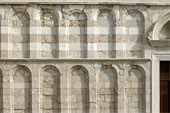 Kvarner is an area whose eventful history dates back to prehistoric times and antiquity. As the period of antiquity drew to a close, barbarian invasions through the Danube
limes became more frequent and intense. For this reason, a system of defensive fortifications, the so-called Alpine Enclosure, was built in the 4th century AD to protect the inner area of the Western Roman Empire. The main logistics base was established in the port town of Tarsatica, in the location of today’s Rijeka, which had had little importance until then. In the 6th century, Kvarner was the location of Justinian’s Reconquista, an imperial project to reclaim the areas lost to barbarian invasions and bring them back into the Eastern Roman Empire. At that time, the coastal
limes was built, a chain of early Byzantine fortifications, minor outposts and observation points, whose purpose was to help control and defend the sea route along the eastern Adriatic coast. Kvarner is an area whose eventful history dates back to prehistoric times and antiquity. As the period of antiquity drew to a close, barbarian invasions through the Danube
limes became more frequent and intense. For this reason, a system of defensive fortifications, the so-called Alpine Enclosure, was built in the 4th century AD to protect the inner area of the Western Roman Empire. The main logistics base was established in the port town of Tarsatica, in the location of today’s Rijeka, which had had little importance until then. In the 6th century, Kvarner was the location of Justinian’s Reconquista, an imperial project to reclaim the areas lost to barbarian invasions and bring them back into the Eastern Roman Empire. At that time, the coastal
limes was built, a chain of early Byzantine fortifications, minor outposts and observation points, whose purpose was to help control and defend the sea route along the eastern Adriatic coast. There are dozens of such points all over Kvarner. Some of them are located on the inner sea route between the islands and the mainland (Lopar in the eastern suburb of Novi Vinodolski, Korintija at Cape Sokol in the north-east of the island of Krk). Some are located on small, distant islands or rocks that can be reached only by boat (Palacol near the island of Oruda). Inside these fortifications churches were built. Since they continued to serve as places of worship through later history, today they are generally the most preserved parts of these locations. The fortification on the slopes of Kamenjak, above the settlement of Barbat on the island of Rab, contains a well-preserved ruin of a single-aisled church with a broad, semicircular sanctuary. The church is dedicated to St. Kuzma and Damjan, pharmacists and surgeons who were worshipped by isolated military crews. On the small island of Sv. Marko, which today supports the arches of the Krk Bridge, are some remains of the single-aisled church of St. John the Gold-Mouthed (ckrva sv. Ivana Zlatoustog). At the site of Lovreški, on the eastern part of the island of Cres, are the ruins of the single-aisled church of St. Lawrence the Martyr (crkva sv. Lovre mučenika) with a polygonal sanctuary. Many cities of the Roman era were either abandoned or destroyed, like Fulfinum on the island of Krk, or were raised again, but with many difficulties and on a smaller scale, like Osor on the island of Cres. The Late Middle Ages was the beginning of a turbulent era of feudal particularism and changing authorities. This situation stabilised after the area was divided up among the Venetians, the Hungarian-Croatian Kingdom and the German Empire. The first half of the 11th century was the period of early Romanesque and the heyday of Benedictine culture on the Croatian islands. In the Mediterranean area, the members of the order of St. Benedict contributed to the passing of antique knowledge into the Middle Ages by transcribing the manuscripts. The main centre of their activities on Kvarner was the monastery of St. Peter in Osor on the island of Cres, while another important centre was the church of St. Peter in Supetarska Draga on the island of Rab. Small, mostly Romanesque, churches are a valuable part of the cultivated landscape on Kvarner. Dozens of such humble, single-aisled churches with a semicircular apse are scattered across this unique landscape imbued with dry-stone walls along the coastline and on the islands. These churches are of Romanesque type, although they were built in the 13th or even 14th century. On the island of Cres there are some transitive Romanesque-Gothic churches with semicircular sanctuaries, while the naves are vaulted with pointed arches (the churches of Sv. Rok and Sv. Nedjelja in the village of Filozići). There are several occurrences of a vault being inserted into a Romanesque construction (the church of Sv. Kristofor or Krstipul above Martinšćica). The next period, the Venetian Gothic, was brought to the islands by the members of the Franciscan order. The first building constructed in this new style, the Franciscan church in the town of Krk (beginning of the 14th century), was followed by many monasteries. The continental Gothic style came to Kvarner through the county of Pazin, and traces of it are today present underneath the Baroque layers of the parish churches in the towns of Lovran and Brseč, as well as in the former Augustine and nowadays Dominican church of St. Jerome. The Late Gothic churches on the island of Cres were built by master builders from eastern Istria (for example, the church of St. Mary Magdalene in Filozići). The first signs of the early Venetian renaissance can be found in the new cathedral in Osor on the island of Cres. This church, together with some aristocrats’ palazzos represented the swan song of this ancient city. The construction was led by Codussi’s disciple G. da Bergamo, and the sculptures were created by G. Buora. While building the new parish church in Cres, the town which began developing rapidly on the back of the deserted, malaria-ridden town of Osor (which at that time was already only nominally the centre of the diocese), the master builder Franjo utilised some of the experience gained from Osor. On the islands of Rab and Krk, not only the Venetian, but also the Florentine influence is present, having come there indirectly through the Hungarian court. Some of the travelling master builders who worked there were the Albanian Andrija Aleši and the Croat Petar Radov Trogiranin. During the late Venetian administration, the islands stagnated, with the exception of some semi-urban and rural settlements. The fishing villages of Mali Lošinj and Veli Lošinj only developed during the heyday of sailing on Kvarner at the end of the 18th into the 19th century. The baroque churches of St. Anthony the Abbot (crkva sv. Antuna opata) and Our Lady of the Angels (crkva Gospe od Anđela) in Veli Lošinj host works of art that were brought there from Venice by Lošinj’s skilled seamen. A great part of the settlement of Lubenice on the island of Cres was built in the 17th and 18th century. The little town of Beli, with clear pre-antique and antique roots, consists today mostly of newly built houses, except the parish church which is a Romanesque building with some earlier substructions. The value of these settlements is in the fact that they fold so neatly into the surrounding landscape. From the mid-17th century, the towns of Liburnian Istria began to prosper, towns that until then had been heavily damaged in Venetian attacks during the uskok wars. The outstanding prehistoric location, the medieval organisation as towns within walls, and a unique combination of baroque architecture with a rather continental atmosphere and the Mediterranean tradition of using flagstones and cobblestones for pavements, give towns like Brseč and Mošćenice a very special appearance. The old town of Lovran stands out for its baroque palaces. The Baroque era in Rijeka began with the circular Jesuit church of St. Vitus (crkva sv. Vida), but the real flourishing of the town came with the Habsburg’s maritime and mercantilist politics in the 18th century. That was the time of major public building projects, like the construction of the Lazarett (today the headquarters of the Rijeka Fire Brigade) in 1725. That was also the time of foreign investments, like the Flemish investment in the Rijeka Sugar Refinery in the second half of the 18th century. Some of the original Refinery’s warehouses have been partly preserved at the location opposite the railway station. Well preserved too is the Refinery’s administrative building, depicted with rococo and baroque-classicistic frescos. In Rijeka, a town with dozens of preserved marble baroque altars, sculptors from Gorica left their mark, like G. and P. Paccassi and P. Lazzarini, or J. Contiero, Padovanac with workshop in Ljubljana. Rijeka gradually became the dominant centre from which master builders or stone masons (A. Verneda, B. and G. Martinuzzi, A. Michelazzi) began to work in the surrounding areas, some of them even on Venetian properties on Kvarner, thus breaking the monopoly that until then had belonged to the masters from the lagoon. In the second decade of the 19th century, the façade of the church of Our Lady of Assumption (crkva Uznesenja Marijina) in Rijeka was enhanced with a classicist adornment to the design by J. Storm. Count L. Nugent, inspired by the awakening of Croatian national consciousness and the doom of the Frankopan dynasty, conducted a romantic renovation of Trsat Castle. In the national context, these were prestigious ventures marking the beginning of a new period. 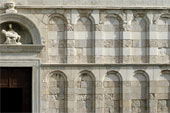 A
row of well-preserved, single-aisled churches with polygonal
sanctuaries, often vaulted with cross-ribbed arches, attest to the
development of the Gorski kotar region in the first half of the 18th
century. Stylistically they belong to the baroque and gothic periods
that are typical of the mountain areas, like the church of St. Michael
(Sv. Mihovil) in the cemetery in Šimatovo, the church of the Holy Spirit
(Sv. Duh) in Male Drage, and the church of St. Rok in the cemetery in
Brod Moravice. Church interiors used to be decorated with vegetable
ornaments. Following the sub-Alpine tradition, decoration also started
appearing on outer façades. On the Church of Our Lady (crkva Majke Božje
Škapularske) in the village of Moravička Sela, adornments have been
modelled in the Mannerist style. Also preserved is a magnificent
polychrome altar retable carved in wood from the first half of the 18th
century. A wood-carved altar retable dating from the beginning of the
18th century is preserved in the church of St. Peter and Paul in
Osojnik. Development became more intense after the first unsurfaced road
was laid between Rijeka and Karlovac. The church of St. Francis (crkva
sv. Franje) in Rtić near Lukovdol is an example of late baroque Gesamtkunstwerk achievement, with extravagant illusionistic painting and
altar retables. A typical late baroque church with built-on chapels is
the votive church of Our Lady in Sveta Gora near Gerovo. Baroque facades
are still present on the parish church of St. Hermagor and Frotunat in
Gerovo (first half of the 19th century). Preserved fragments of castles
built by the Zrinski family can be found in Čabar, and one of their
castles has been preserved entirely in Brod na Kupi. A
row of well-preserved, single-aisled churches with polygonal
sanctuaries, often vaulted with cross-ribbed arches, attest to the
development of the Gorski kotar region in the first half of the 18th
century. Stylistically they belong to the baroque and gothic periods
that are typical of the mountain areas, like the church of St. Michael
(Sv. Mihovil) in the cemetery in Šimatovo, the church of the Holy Spirit
(Sv. Duh) in Male Drage, and the church of St. Rok in the cemetery in
Brod Moravice. Church interiors used to be decorated with vegetable
ornaments. Following the sub-Alpine tradition, decoration also started
appearing on outer façades. On the Church of Our Lady (crkva Majke Božje
Škapularske) in the village of Moravička Sela, adornments have been
modelled in the Mannerist style. Also preserved is a magnificent
polychrome altar retable carved in wood from the first half of the 18th
century. A wood-carved altar retable dating from the beginning of the
18th century is preserved in the church of St. Peter and Paul in
Osojnik. Development became more intense after the first unsurfaced road
was laid between Rijeka and Karlovac. The church of St. Francis (crkva
sv. Franje) in Rtić near Lukovdol is an example of late baroque Gesamtkunstwerk achievement, with extravagant illusionistic painting and
altar retables. A typical late baroque church with built-on chapels is
the votive church of Our Lady in Sveta Gora near Gerovo. Baroque facades
are still present on the parish church of St. Hermagor and Frotunat in
Gerovo (first half of the 19th century). Preserved fragments of castles
built by the Zrinski family can be found in Čabar, and one of their
castles has been preserved entirely in Brod na Kupi. Rijeka’s greatest period of development came at the end of the 18th century, with industrial production reaching a peak at the turn of the 19th and 20th centuries. Due to the construction of industrial plants, filling in the waterfront to create a modern harbour, railway (1873) and road connections with the hinterland and the cities of Central Europe (Budapest and Vienna), Rijeka became an important port and industrial transit centre with a Central European appearance rather than the Mediterranean appearance one might expect considering its geographical position on the Adriatic coast. Traces from the period between 1868 and the end of World War I, in which Rijeka was under Hungarian administration, can be found in the town’s urban structure, in the plans from the era of mayor Giovanni de Ciotta (1872 – 1896), in historicist and belle époque architectural features, and in large-dimensioned public, industrial and residential buildings with decorated facades, most of them built to the plans by state architects from Budapest, Trieste and other nearby centres of the Austro-Hungarian Monarchy. The Italian rule on Kvarner in the period between the two world wars saw the construction of rationalist, functional buildings designed to classical models. As tourism flourished on Kvarner in the 19th century, some fine examples of summer villas were built in the areas of Opatija, Lovran, Lošinj and Crikvenica. Some of these valuable projects were designed by the Viennese architect Carl Seidl, but local builders also got involved, like Andrea Rubinich and Attilio Moguolo, who built the villas of San Giovanni, Adela and Rosenvilla. Buildings that stood out by their grandeur and location in the bay of Lovran were the Grand Hotel Laurana (today the Orthopaedic Clinic), the belle époque Hotel Exelsior (1912), and the vividly coloured Villa Gianna (1904) in the centre of the town. One should also not miss the historicist hotels and guesthouses in Opatija like the Kvarner (1884, architect Wilhelm), the Imperial and the Opatija (1885). The most significant historicistic (neo-Gothic) and belle époque builders on Kvarner were Carl Seidl, Max Fabiani and Carlo Conighi. Their architecture is of great environmental value due to the degree of attention they paid to surrounding parks, gardens and lush Mediterranean green areas. Public architecture in Opatija also includes the simple building of the Zora cultural society (founded in 1889), the splendid historicist palace Casino di Lettura (today a shopping centre), or the Villa Rosalia (1896) that used to be very luxuriously furnished. Opatija hosts the large neo-Romanesque church of Our Lady of Annunciation (crkva Marijina Navještenja) with a remarkable dome (1906 – 1932) and luxuriant villas spread along the coastline towards Volosko, from villa Papo up to villa Madonna. Outstanding examples are the summer villas of Frappart, Magnolija and Astra, and the villa by Jakob Ludwig Münz, located directly above the sea and decorated with stained-glass windows from Innsbruck and the famous Hungarian Zsolnaj ceramics. In contrast to the above is the folk architecture of single-storey stone-built houses with a cellar in the ground floor that usually includes a trade workshop or a shop, typical of the entire coastal part of this region. This architecture follows the centuries-long tradition on Kvarner. It disappeared from the centre of Rijeka due to lack of maintenance, but this was fortunately not the case elsewhere. Along the coastline and on the islands there are still some ancient hilltop settlements, built as a result of the coastline descending so steeply into the sea underneath Mount Učka, or for safety reasons, for easier defence against attacks from the sea. These hilltop settlements used to be surrounded by defensive walls, have a main gate to the town, a roofed loggia for meetings, a central church with a high belfry, and a row of densely packed, mainly single-storey, stone houses with a terrace above the entrance into the cellar on the ground floor. In front of the church is usually the main town square, the venue for important events and celebrations. There are several such settlements on the islands, but their population has been drastically reduced over time. Today’s town of Rijeka stretches along the coastline and up the hills of Kozala, Trsat, Drenova and further into the hinterland. Some of the valuable buildings in Rijeka from the period between the two world wars were designed by the architects from Italy and Rijeka’s Technical Office (B. Angheben, R. Puhali, Dujmich, Y. Clerici) or from Trieste (Nordio-Frandoli). Part of the town, Sušak, is the location of some buildings designed by Croatian architects from Rijeka or Zagreb (J. Pičman - A. Albini, K. Ostrogović, I. Emili, D. Buneta). After World War II, mostly tower blocks and residential settlements on the outskirts of the town were built, as well as some large public buildings in the centre, like the church of St. Nicholas (B. Magaš), the Ri department store (N. Kučan), and the Croatia Line building (V. Grubišić). Fulfinum was an ancient port town on the island of Krk, originally inhabited by Roman veterans that shared the same destiny as many ancient towns. It was abandoned after the barbarian invasions, when its population took shelter on a hill that was easier to defend - the location of today’s town of Omišalj. Some fortified hills have been continuously inhabited since the Iron Ages. In antiquity they continued to live in direct contrast to the Roman town beneath the hill. During the barbarian invasions they gained importance as places of refuge for people from the surrounding areas. But even after Fulfinum was ruined, a large early Christian church with a three-leafed layout in the form of a Latin cross continued to exist for some time on its outskirts. Such spots came into the possession of the Benedictines in the early Middle Ages. When maintenance of the huge roofs constructed in late antiquity became too expensive, the monks built new churches. In the same location are the preserved remains of such a small, three-apsed building constructed upon the floor that was made using the so-called opus spicatum technique (the floor is a remnant of an earlier ancient piece of architecture). Similar in structure is the three-apsed church in a former Benedictine abbey in Dol pod Grotom, near Beli on the island of Cres. Tarsatica is the town from late antiquity out of which today’s town of Rijeka has grown. In the Roman era it was militarised and turned into a fortified castrum with a military headquarters in its centre. Its remains today include the representative portal (for centuries known as the Roman Arch), cobbled courtyards and external town walls, constructed with a characteristic combination of scattered pieces of stone and levelling layers of large Roman roof tiles called tegula. The remains of ancient Tarsatica can still be found inside the original town walls featuring the Clock Tower, the former main entrance to the town that preserved its original antique location despite numerous changes throughout history. From Kobler Square in front of the Roman Arch, the centre of the medieval commune, Užarska Street runs to the east following the route of the antique decumanus. Along this main town artery, several floor mosaics dating from late antiquity can be seen, like the ones that were found in the surrounding area and are now presented in the late Gothic-Baroque Garbas house at Užarska 26. At the eastern end of the Old Town, the former Tarsatica, in an area that had plenty of water from the nearby stream and bordered on the harbour in the River Rječina estuary, public baths were built in late antiquity. Here, among merchants, dock workers and soldiers gathered from all over the empire, the teachings of the early Christians began to spread, which is why this became the first Christian place of worship. The church of Our Lady of Assumption (crkva Uznesenja Marijina), built above the thermae, features early Christian floor mosaics in the substructure, as well as layers from the medieval (Romanesque and Gothic) and baroque and classicist phases. 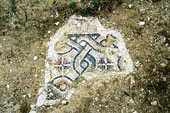 The Early Christian floor mosaics on the islands
are often found
as a result of the Kvarner islands becoming refuges for people fleeing
from the mainland in the late antiquity. Extravagant mosaics were found
and preserved beneath the cathedrals of Krk, Rab and the old cathedral
in Osor (today’s church of St. Mary in the cemetery), then in the
sanctuary of the former church of St. John the Evangelist (crkva sv.
Ivana Evanđelista) on the island of Rab, and beside the Romanesque
church of St. Marco in Baška on the island of Krk, built upon the
remains of the basilica there with a nave and two aisles. From the
earlier period of classical antiquity, a part of the mosaic showing
Triton and a dolphin from the thermae (baths) of Krk has been preserved
– it is displayed in the side room of a local inn. The Early Christian floor mosaics on the islands
are often found
as a result of the Kvarner islands becoming refuges for people fleeing
from the mainland in the late antiquity. Extravagant mosaics were found
and preserved beneath the cathedrals of Krk, Rab and the old cathedral
in Osor (today’s church of St. Mary in the cemetery), then in the
sanctuary of the former church of St. John the Evangelist (crkva sv.
Ivana Evanđelista) on the island of Rab, and beside the Romanesque
church of St. Marco in Baška on the island of Krk, built upon the
remains of the basilica there with a nave and two aisles. From the
earlier period of classical antiquity, a part of the mosaic showing
Triton and a dolphin from the thermae (baths) of Krk has been preserved
– it is displayed in the side room of a local inn.The early Croatian burial grounds in the Vinodol region originate from the early Middle Ages when the continental part of Kvarner belonged to the Croatian Principality, and the islands still came under Byzantine authority. The Croats, key allies of the Franks in the battle against Avar Khaganat, had very advanced military equipment, which we know about from the items found in the early Croatian burial ground of Stranče in the Vinodol region. Besides weapons and spurs, earrings used to be placed in the tombs. These came from manufacturers who produced jewellery under the influence of the Dalmatian towns. These items are now kept in the History and Maritime Museum in Rijeka. Carolingian influences in architecture and sculpture were very strong in the early Middle Ages. In architecture this mainly refers to the renovation of antique buildings. In sculpture it means the presence of stonemason’s workshops from Carolingian Istria, and even the use of soft stone from Istrian quarries that can be shaped more easily. The stone altar adornments include the typical motifs of overlapping triple ribbons interwoven with motifs of lilies, rosettes and animal details (birds, lions, etc.). The motifs of Christian symbolism were often taken from early Christian floor mosaics. Many finds of pre-Romanesque sculpture in dozens of churches on the islands attest to the prosperity and political importance that Kvarner enjoyed at that time, being the centre of attention of major forces, the Byzantine Empire and the Franks. Worth visiting are the pre-Romanesque works in the museum and the collection of sacred artefacts in Osor on the island of Cres (both on the main square besides the parish church), collections in Krk cathedral, in the parish church in Omišalj and the nearby lapidarium, and the Rab lapidarium in the renaissance church of St. Christopher (crkva sv. Kristofora). Benedictine communes used to be the centres of culture on the islands of Kvarner, the most prominent of them probably being the monastery of St. Peter in Osor on the island of Cres, founded by St. Gaudencije, a bishop from Cres. Reliefs that were once part of the early Romanesque adornments on the façade of the church of St. Peter were set into the walls of the houses in the surrounding area. The ruins of the church still contain the vaulted oratory with a niche for relics. Similar liturgical spaces have also been found in the ground floors of the early Romanesque belfries of St. Andrew and St. John the Evangelist on Rab. The sanctuary of the latter, ruined church contains a rare example of a deambulatory, a covered passage for solemn procession of the monks. The completely preserved church of St. Peter with a nave, two aisle and three apses in Supetarska Draga also dates from the early Romanesque period. The columns that divide the naves of the church are decorated with skilfully chiselled antique-like capitals that are characteristic of Benedictine stone mason’s workshops on Kvarner. The blind arcades on the façade of Rab Cathedral and its belfry date back to the 12th century, the period of late Romanesque. The treasure chamber of the cathedral hosts some of the finest examples of the Romanesque goldsmith’s trade, like the St. Christopher’s reliquary and parts of the adornment from a portable altar with enamel figures of the apostles. The Romanesque style on the island of Krk developed under the influence of craftsmen from Zadar. This can be seen from the typologically unique two-storey Romanesque church of St. Quirinus (crkva sv. Kvirina) that was built the end of the 12th century along the façade of the cathedral of Our Lady of the Assumption in the town of Krk. This excellent late Romanesque realisation (blind arches and cordon cornices on the apses, cubic capitals) attests to the political and economic rise of the dukes from Krk. Some three-leafed churches with a central ground plan like the church of St. Dunat near Punat and the church of St. Krševan near Milohnići date from the same period. Their origin is connected with the spreading of the jurisdiction of the Zadar archdiocese to the area of the Krk diocese. The culture of Glagolitic Benedictine monasteries is represented by the superbly preserved monastery church of St. Lucy (crkva sv. Lucije) in Jurandvor. Castles built in the Romanesque style are no rarity on Kvarner. Some fine examples include the fortresses of Krk’s Fortičini dukes near Omišalj and the fortress of Gradec near Risika also on the island of Krk. In the Vinodol region there is the castle of Belgrad, a fortified building that was partly built in this period, and before that in two earlier, late antique phases. The impressive ruins of Vinodol’s Ledenice and Hreljin castles, abandoned hundreds of years ago, are also fine examples of the Romanesque building period. This is also true for the northern part of Kastav’s town walls, in the area of Žudika. The Renaissance master builders from the Vinodol region had to seek work on the islands because building activities in the hinterland of Vinodol were reduced due to the Turkish threat, with the exception of works on fortifications. This is why the religious buildings built in the Vinodol area in the late 15th and the 16th century were mainly small, single-aisled late Gothic churches with a rectangular sanctuary (Bernardin Frankopan’s foundation), or the slightly more luxurious Paulist monasteries (Novi, Crikvenica). The defence of the castles was increased, particularly the castles of Trsat, Bakar, Grobnik, Drivenik, Ledenice, Novi and Grižane. Vinodol became the region of refuge for the clergy and inhabitants from the mainland, which explains the fact that many churches in this region even today host some fine examples of the Romanesque and Gothic goldsmith’s trade (Bribir, Novi, Bakar). At this time, from the court of Corvinus in Hungary, also came the Master of marble Madonnas who had been educated in Florence (the parish church in Bribir). Gothic, renaissance and Mannerist wood-carved sculptures have been very well preserved on Kvarner, partly because some items were the subject of particular worship, like the early Gothic miraculous crucifix of St. Vitus (sv. Vid) in Rijeka. In some smaller milieus these items remained preserved because in the baroque era there were no economic resources left to replace the old altar retable with a modern marble one. Artists who created some noted works were M. Moronzoni (choir stalls in Rab), A. da Murano (Virgin and Child in Cres and Vrbnik), P. Camps and G. da Malines (retables in Baška and Vrbnik). Also worth mentioning are the main altars of the parish churches in Vrbnik and Dobrinj, the altar of St. Klement in Klimno, and the collections of sacred artefacts in Krk, Dobrinj, Vrbnik, Osor and Rab. 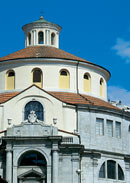 Baroque
first appeared in the Jesuit church of St. Vitus (crkva sv. Vida) in
Rijeka, the unfinished Crekvina in Kastav and the parish church in
Mošćenice. Baroque elements in the Franciscan monastery of Trsat
appeared as early as the second quarter of the 17th century, and shortly
after that in the courts of Stari dvor and Novi dvor in Kraljevica. The
Sugar Refinery administrative building in Rijeka is the largest work of
secular architecture dating from the second half of the 18th century.
The parish church of St. Andrew (sv. Andrija) in Bakar, the largest
church on Kvarner, demonstrates the late baroque aspirations of 19th
century architecture. Baroque
first appeared in the Jesuit church of St. Vitus (crkva sv. Vida) in
Rijeka, the unfinished Crekvina in Kastav and the parish church in
Mošćenice. Baroque elements in the Franciscan monastery of Trsat
appeared as early as the second quarter of the 17th century, and shortly
after that in the courts of Stari dvor and Novi dvor in Kraljevica. The
Sugar Refinery administrative building in Rijeka is the largest work of
secular architecture dating from the second half of the 18th century.
The parish church of St. Andrew (sv. Andrija) in Bakar, the largest
church on Kvarner, demonstrates the late baroque aspirations of 19th
century architecture.Classicism came to Kvarner through Trieste, its most prominent realisation being the façade of the church of Our Lady of the Assumption (crkva Uznesenja Marijina) in Rijeka from the second decade of the 19th century. The renovation of Trsat Castle in the first half of the 19th century was the first romantic renovation of a medieval castle in Croatia. 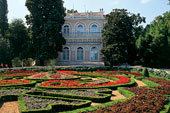 The Villa Angiolina
marked the beginning of a new era in Opatija. After the villa’s
construction in 1844, this small fishing village swiftly developed into
a renowned seaside and health resort, especially after the Viennese
Southern Railways Company came here in 1880. It was the time when many
hotels, summer houses, guesthouses, pavilions, sanatoriums, swimming
baths, parks and promenades were built. In 1889 Opatija was officially
proclaimed an elite winter and summer health resort, a destination whose
guests came mainly from Vienna. The tradition of welcoming famous
personalities from politics and culture, and even crowned heads, was
started by Higin Scarpa who built this classicist villa with its
surrounding gardens. The Villa Angiolina
marked the beginning of a new era in Opatija. After the villa’s
construction in 1844, this small fishing village swiftly developed into
a renowned seaside and health resort, especially after the Viennese
Southern Railways Company came here in 1880. It was the time when many
hotels, summer houses, guesthouses, pavilions, sanatoriums, swimming
baths, parks and promenades were built. In 1889 Opatija was officially
proclaimed an elite winter and summer health resort, a destination whose
guests came mainly from Vienna. The tradition of welcoming famous
personalities from politics and culture, and even crowned heads, was
started by Higin Scarpa who built this classicist villa with its
surrounding gardens. The
Villas by Carl Seidl in Lovran from the turn of the 19th and 20th
centuries are considered the most valuable examples of the architecture
of historicism and secession. The most impressive of these were built
for wealthy clients from Austria and are characterised by asymmetric
ground plans and dimensions, luxurious interiors, details on the
facades, mosaic decorations and lushly maintained gardens. He built the
villas of Frappart, Santa Maria, Guera, Magnolia and others.
Several examples of Seidl’s work can also be found in Opatija where he
built the Villa Ariston and the small neo-Romanesque evangelic church. The
Villas by Carl Seidl in Lovran from the turn of the 19th and 20th
centuries are considered the most valuable examples of the architecture
of historicism and secession. The most impressive of these were built
for wealthy clients from Austria and are characterised by asymmetric
ground plans and dimensions, luxurious interiors, details on the
facades, mosaic decorations and lushly maintained gardens. He built the
villas of Frappart, Santa Maria, Guera, Magnolia and others.
Several examples of Seidl’s work can also be found in Opatija where he
built the Villa Ariston and the small neo-Romanesque evangelic church.The Korzo is the main town promenade in Rijeka built at the end of the 19th century and the beginning of the 20th, after tearing down the southern town walls and filling in the waterfront. The southern row of houses is dominated by the tall belle époque building of the former Hotel Royal (now the seat of the County and the Magma department store), whose upper façade is decorated with a stylised vegetable ornament, and the ground floor and the mezzanine with an open iron structure with large glass surfaces that was characteristic of the period. Similar in height is the house with stone relief balcony fences and glazed mezzanine at the other end of the Korzo. It was built by the architect Giacomo Mattiassi and once hosted a cinema. Also worth mentioning is the neo-renaissance Post Office building (end of the 19th century) and the picturesque narrow, yellow belle époque Milcenich-Cerniak house, designed by E. Ambrosini. On the opposite side is the classicist building now hosting the local radio station Radio Rijeka (1845), with a balcony supported by pillars, built to the design by Antonio Deseppi from Rijeka. It hosted the Public Reading Room (Narodna čitaonica) from 1889 – 1927. It was here that the political document called the Rijeka Resolution was issued in 1905. A few steps further on is the historicist façade of the Filodrammatica building, richly decorated with pillars and female figures, designed in 1890 by Giacomo Zammattio from Trieste for musical and stage performances. Behind its ornate neo-renaissance façade is the interior with rococo stuccoes (L.Strichtius) and a concert hall on the first floor with ceiling paintings by Eugenio Scomparini from Trieste. 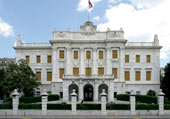 The
Governor’s Palace was built as a residence for the Hungarian
governor who ruled Rijeka from 1868 until 1914. It was designed in 1896
on behalf of the governor Lajos Batthyany by the Budapest architect
Alajos Hauszmann in the style of late historicism with a neo-renaissance
texture. Both the interior (the atrium, the salons and the Marble Hall)
and the exterior with a monumental façade, arcade wings and the park
were designed to serve the protocol. Located on a hilltop position, this
palace has had an eventful history as the real and symbolic seat of
state administration. It was the venue of fight between Italian
annexionists (the Arditi) lead by the poet Gabriele D’Annunzio and the
supporters of Rijeka’s independence and annexation to the State of the
Slovenes, Croats and Serbs. The Palace today hosts the Maritime and
History Museum of the Croatian Littoral. The
Governor’s Palace was built as a residence for the Hungarian
governor who ruled Rijeka from 1868 until 1914. It was designed in 1896
on behalf of the governor Lajos Batthyany by the Budapest architect
Alajos Hauszmann in the style of late historicism with a neo-renaissance
texture. Both the interior (the atrium, the salons and the Marble Hall)
and the exterior with a monumental façade, arcade wings and the park
were designed to serve the protocol. Located on a hilltop position, this
palace has had an eventful history as the real and symbolic seat of
state administration. It was the venue of fight between Italian
annexionists (the Arditi) lead by the poet Gabriele D’Annunzio and the
supporters of Rijeka’s independence and annexation to the State of the
Slovenes, Croats and Serbs. The Palace today hosts the Maritime and
History Museum of the Croatian Littoral.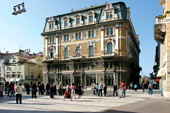 The
Modello Palace, a work by the Atelier Helmer & Fellner from Vienna
was built in 1885 for the Town Bank. Its façade features a combination
of neo-renaissance reliefs and exuberant neo-Baroque reliefs. The
extravagant ornamentation is enhanced by gentle stucco works on the
staircase and gilded adornments in the interior, especially in the
ballroom. The Modello Palace is an ambitious attempt to imitate the
architecture of the Vienna Ring in a constant rivalry with Trieste.
Today the Palace is home to the Town Library and the seat of the Italian
union, the popular Circolo italiano di cultura. The
Modello Palace, a work by the Atelier Helmer & Fellner from Vienna
was built in 1885 for the Town Bank. Its façade features a combination
of neo-renaissance reliefs and exuberant neo-Baroque reliefs. The
extravagant ornamentation is enhanced by gentle stucco works on the
staircase and gilded adornments in the interior, especially in the
ballroom. The Modello Palace is an ambitious attempt to imitate the
architecture of the Vienna Ring in a constant rivalry with Trieste.
Today the Palace is home to the Town Library and the seat of the Italian
union, the popular Circolo italiano di cultura.The Jadran Palace (Palazzo Adria) was built as the seat of a major Hungarian shipping company to the plans of Vilmos Freund, but it was modified by the architects from Rijeka Franjo Matijasić and Giacomo Zammattio during its construction in 1884. The Venetian sculptor Sebastiano Bonomi created four large sculptures for each large façade representing four continents (Europe, America, Africa and Asia) and naval professions (captain, pilot, helmsman and engineer). The railway station in Rijeka was built in 1890, after construction of the railway from Ljubljana and Budapest in 1873, by Ferenc Pfaff, the buildings expert for Hungarian Railways (MAV) from Budapest. The neo-classical building consists of three pavilions connected by lower wings. By locating the building off the main street, it was possible to form a square in front of the station, thus creating a sense of monumentality despite the fact that the surrounding buildings are higher than the railway station The Croatian National Theatre Ivan pl. Zajc was built in 1885 to the designs of the Helmer & Fellner atelier from Vienna, which specialised in theatre buildings throughout the Austro-Hungarian Empire. The theatre’s interior design, which reflects the Central European atmosphere of the town, resulted from the collaboration of regular associates of the atelier, Matsch, Kauffungen and Fritsch, and the Klimt brothers. The gable of the main façade features compositions of the figures Music and Drama, a work of the Venetian sculptor Benvenuti. In a town without electricity, the autonomous electrical lighting system, installed in the theatre building in 1885 by the Viennese firm of Kremenezky, was a real sensation. In front of the theatre is a smaller park that was reconstructed in 2005 as a replica of the historicist park. 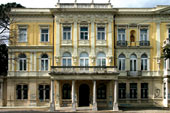 The
Archduke’s Palace, the so-called Villa Giuseppe in Rijeka, was
reconstructed in 1892 by the Rijeka architects Pietro and Raffaelle
Culotti for Archduke Joseph Habsburg (Bratislava 1833 – Rijeka 1905),
cousin of the Emperor and King Franz Josef I. Being an internationally
renowned natural scientist, he laid out a botanical garden around his
residence using exotic plants from all over the world. Today this richly
decorated historicist property, surrounded by a park instead of the
former gardens, hosts the State Archive in Rijeka. The
Archduke’s Palace, the so-called Villa Giuseppe in Rijeka, was
reconstructed in 1892 by the Rijeka architects Pietro and Raffaelle
Culotti for Archduke Joseph Habsburg (Bratislava 1833 – Rijeka 1905),
cousin of the Emperor and King Franz Josef I. Being an internationally
renowned natural scientist, he laid out a botanical garden around his
residence using exotic plants from all over the world. Today this richly
decorated historicist property, surrounded by a park instead of the
former gardens, hosts the State Archive in Rijeka.Kozala cemetery is an important monument of landscape architecture and an open-air sculpture park. It was opened to the public in 1838 and designed according to the plans of Luigi de Emilys (1851) and Venceslao Celligoi (1892 – 1915), who inspired the basic horseshoe-shaped ground plan. Among its many private chapels and mausoleums it includes works by Ivan Rendić (historicist mausoleums of Gorup 1882, Manasteriotti 1894, dall’ Asta-Mohovich 1899), G. Zammatti (the belle époque Whitehead mausoleum 1905), and mausoleums for the families of Scarpa (1861), Ploech (1888), Vio-Baccarcich (1889), Gelletich-Nicolaides (1896), etc. The Kozala cemetery includes works by almost all the architects, sculptors, monumental masons and painters who worked in Rijeka at the turn of the 19th and 20th centuries. 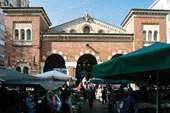 The
town market place in Rijeka consists of two pavilions and a
fish-market. It is located in the centre of the town, near the Theatre
and the Modello Palace. The pavilions were designed by the engineer I.
Vauchnig from the Municipal Technical Office. The walls on the shorter
façades are solid, but the longer, lateral sides have almost no walls at
all as they are made of glass set into a framework of cast iron. The
fish-market was designed by C. Pergoli from the Municipal
Technical Office who gave it a historicist, basilica-like appearance
with polychrome effects of white stone adornments and red brick walls.
The imaginative sculptural adornments of the capitals and the inner
walls by U. Bottasso from Venice are characterised by belle époque
plasterwork rich in motifs representing marine flora and fauna. There
seem to be no two identical scenes. The
town market place in Rijeka consists of two pavilions and a
fish-market. It is located in the centre of the town, near the Theatre
and the Modello Palace. The pavilions were designed by the engineer I.
Vauchnig from the Municipal Technical Office. The walls on the shorter
façades are solid, but the longer, lateral sides have almost no walls at
all as they are made of glass set into a framework of cast iron. The
fish-market was designed by C. Pergoli from the Municipal
Technical Office who gave it a historicist, basilica-like appearance
with polychrome effects of white stone adornments and red brick walls.
The imaginative sculptural adornments of the capitals and the inner
walls by U. Bottasso from Venice are characterised by belle époque
plasterwork rich in motifs representing marine flora and fauna. There
seem to be no two identical scenes.The Port Warehouses, popularly known as The Metropolis, are located in the port of Rijeka that was built at the end of the 19th century and the beginning of the 20th to the design of French engineer Hilarion Pascal and the Hungarian Antal Hajnal. The historicist warehouses no. 12 (1893 – 1894) and no. 13 (1897 – 1898), designed by Lajos Burgstaller i Vjenceslav Celligoi, with cast iron columns and ceilings of reinforced concrete (the Monier system), are the oldest preserved examples of such buildings in Croatia. The Metropolis complex (1909 – 1914), which to this day remains the largest building project ever undertaken in Rijeka, consists of five warehouses designed by the groups of architects and engineers Wehler, Rolberitz, Bereny, Bela Enyedi, Baranyaj, Prister, Celligoi and Träxler. Two rows of warehouses each over 300 m in length, at a location parallel to the waterfront, make up a street and were connected in 1914 by a series of covered bridges that enabled undisturbed communication between the buildings. The warehouses are rich in details of Hungarian secession, which makes them unique anywhere in the world. At the time of its construction, the Metropolis was a very functional system made of experimentally implemented reinforced concrete, with a very high load-bearing capacity (1500 to 2000 kg/m²) and a modern interior.  The
Church of St. Romuald and All Saints, or the Tempio votivo (1928 –
1934), was designed by Bruno Angheben from Rijeka as a double
memorial church whose crypt contains the remains of Italian victims from
both World Wars. It was planned as a Gesamtkunstwerk, meaning that the
hall church, baptistery, crypt and belfry, parish house and the
surrounding area, intended as a memorial park, were designed in the same
style. Apart from Angheben, who designed the ciborium and the marquetry
on the Stations of the Cross, the decoration was designed by the Rijeka
artists Romolo Venucci (sculptures on the facade) and Ladislao de Gauss
(two apsidal triptychs). The
Church of St. Romuald and All Saints, or the Tempio votivo (1928 –
1934), was designed by Bruno Angheben from Rijeka as a double
memorial church whose crypt contains the remains of Italian victims from
both World Wars. It was planned as a Gesamtkunstwerk, meaning that the
hall church, baptistery, crypt and belfry, parish house and the
surrounding area, intended as a memorial park, were designed in the same
style. Apart from Angheben, who designed the ciborium and the marquetry
on the Stations of the Cross, the decoration was designed by the Rijeka
artists Romolo Venucci (sculptures on the facade) and Ladislao de Gauss
(two apsidal triptychs).The small orthodox synagogue in Rijeka was built between 1930 and 1932, even though an old, historicist synagogue still existed at that time (constructed by Lipót Baumhorn in 1906, but eventually destroyed after World War II). Designed by the architects Győző Angyal and Pietro Fabbro in the Italian rationalist style, today’s synagogue is the only one in Croatia that dates from the period of modern art. Riječki neboder (Rijeka skyscraper) is a rationalist building that was locally nicknamed “the chest of drawers” during its construction from 1939 to 1942. It was designed by Umberto Nordio, a renowned architect from Trieste, as a companion structure to the tower block in another part of the town, Sušak, that was built to the plans by Josip Pičman and Alfred Albini as part of the Croatian House of Culture (Hrvatski kulturni dom) (1936 – 1947). The church of St. Nicholas (crkva sv. Nikole) by the Rijeka architect Boris Magaš, dedicated to the patron saint of sailors, was daringly constructed with modern materials (concrete) as a large tent whose roof construction should partly serve as a promenade for pilgrims. Croatia’s Defenders Bridge (Most hrvatskih branitelja), built in 2002 to plans by the young architects’ studio 3LHD, is a prize-winning modern project of innovative technology stretching over the Mrtvi canal in the centre of Rijeka. The 47-metres-long bridge with a monument 9-metres high has won several international architecture awards. The Krk Bridge with a total length of 1,430 m was built between 1976 and 1980 and represents a significant achievement of civil engineering. The concrete arch connecting the mainland to the island of Sv. Marko has a length of 390 metres. At the time of construction, it was the largest bridge of its kind in the whole world, exceeding the former largest arch bridge, the one in Sydney, by 85 metres. The Hotel Miramare is a massive belle époque building in Crikvenica by the architect Rimanuczy. It was constructed in 1905 for a wealthy clientele, at a time when the town was developing as an elegant seaside and health resort for the Hungarian aristocracy and a direct competitor to nearby Opatija. Mošćenice is a hilltop settlement that was first mentioned in 1374. It has preserved its medieval urban structure with a row of peripheral houses forming the town wall. The only remains of this wall today are a rectangular tower (renovated and turned into a school) and the town gate. Similar ancient hilltop settlements on the coast are Veprinac, Kastav and Grobnik. 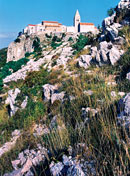 Omišalj,
a medieval settlement above a cove that cuts deeply into the landscape,
is one of the typical hilltop settlements of the Kvarner islands, and
also one of the five castles of the Frankopan family on the island of
Krk. Above the harbour are the ruins of the Gradec fortress. The
Frankopan castle (1442) was destroyed in the course of time, but Omišalj
preserved the irregular medieval layout of streets that meet at the main
square with the loggia, the belfry (both from the 15th century), and the
parish church. There is a similar hilltop settlement on the island of
Krk at Vrbnik, and on the island of Cres at Beli and Lubenice. Omišalj,
a medieval settlement above a cove that cuts deeply into the landscape,
is one of the typical hilltop settlements of the Kvarner islands, and
also one of the five castles of the Frankopan family on the island of
Krk. Above the harbour are the ruins of the Gradec fortress. The
Frankopan castle (1442) was destroyed in the course of time, but Omišalj
preserved the irregular medieval layout of streets that meet at the main
square with the loggia, the belfry (both from the 15th century), and the
parish church. There is a similar hilltop settlement on the island of
Krk at Vrbnik, and on the island of Cres at Beli and Lubenice.Folk architecture in Gorski kotar of the 19th century was characterised by the use of the local building material - wood from the neighbouring forests. The typical house consisted of a wooden superstructure above a stone foundation with embedded cellar, steep wooden roof and a covered passage – locally known as a ganak – to successfully deal with huge amounts of snow. Houses in the rural environment included a room for keeping cattle. Although many such original houses gave way to modern concrete buildings, examples of the original wooden architecture can still be found in Gorski kotar, like the Delač and Ožanić–Žižek houses in Delači and the Mance house in the ethnic village of Kuti. 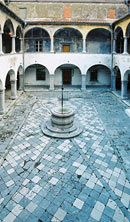 The
Castles of the Zrinski and Frankopan families, Croatian noblemen in
the Middle Ages, were erected right across the Kvarner region. The
Zrinski family built several castles, but none of them has been
preserved completely. Today we can only have a presentiment of their
former grandeur, based on the magnificent remnants of their stone walls.
Among these are the fortress-palace in Brod na Kupi (1651), the Zrinski
manor in Čabar, and the castle (court) in Severin na Kupi, that was the
Frankopan’s property from the 16th century, with a chapel and a
surrounding park. The former Frankopan castle in Stara Sušica belonged to Count Laval Nugent in the 19th century, but was afterwards
sold to the Neubergers. Both owners converted it into a picturesque The
Castles of the Zrinski and Frankopan families, Croatian noblemen in
the Middle Ages, were erected right across the Kvarner region. The
Zrinski family built several castles, but none of them has been
preserved completely. Today we can only have a presentiment of their
former grandeur, based on the magnificent remnants of their stone walls.
Among these are the fortress-palace in Brod na Kupi (1651), the Zrinski
manor in Čabar, and the castle (court) in Severin na Kupi, that was the
Frankopan’s property from the 16th century, with a chapel and a
surrounding park. The former Frankopan castle in Stara Sušica belonged to Count Laval Nugent in the 19th century, but was afterwards
sold to the Neubergers. Both owners converted it into a picturesque  romantic
building with several little towers, following the contemporary fashion.
Today this castle is open to school pupils as a venue for outdoor
classes throughout the year. Castles of the Zrinski and Frankopan
families were also erected along the coastline: Trsat, Grobnik, Bakar,
Kraljevica, Ledenice, Bribir, Hreljin, Grižane and Novi Vindolski, while
on the islands are the castles of Krk and Gradec. romantic
building with several little towers, following the contemporary fashion.
Today this castle is open to school pupils as a venue for outdoor
classes throughout the year. Castles of the Zrinski and Frankopan
families were also erected along the coastline: Trsat, Grobnik, Bakar,
Kraljevica, Ledenice, Bribir, Hreljin, Grižane and Novi Vindolski, while
on the islands are the castles of Krk and Gradec. |
|
|
|
|||||
 THE KVARNER COUNTY TOURISM OFFICE 51410 Opatija, Nikole Tesle 2, tel: +385/51/272-988, fax: +385/51/272-909 http://www.kvarner.hr, e-mail:kvarner@kvarner.hr |
|||||